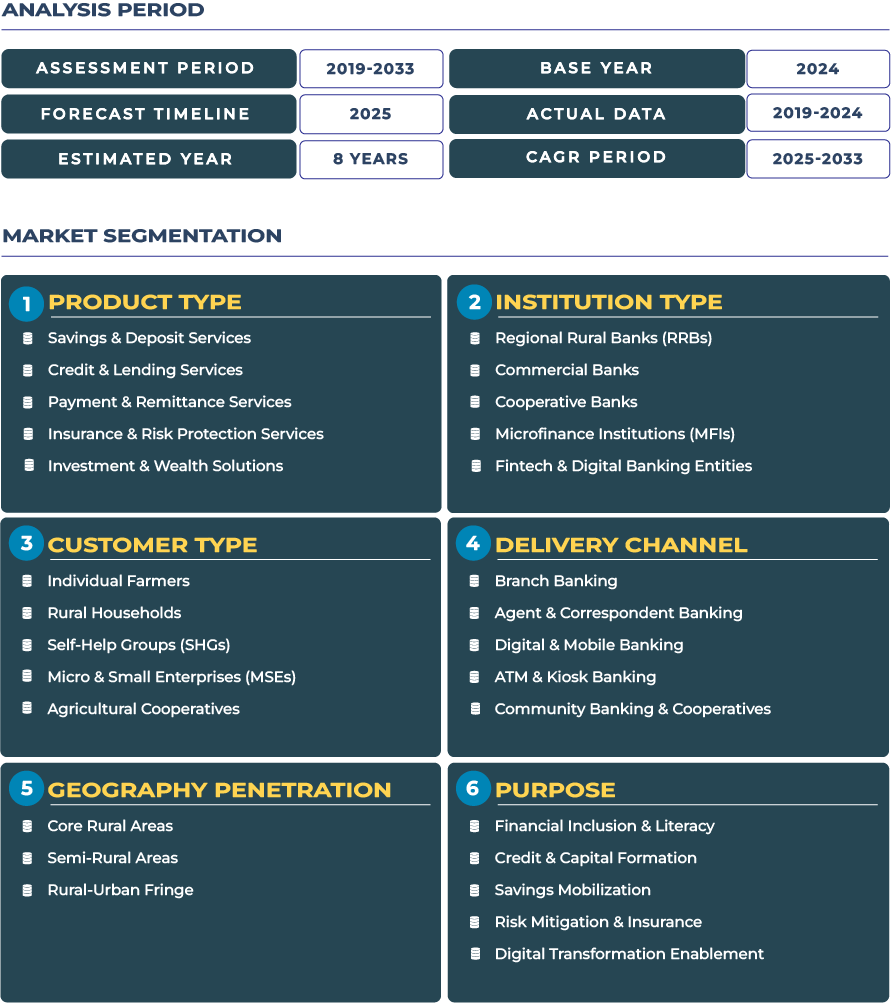Spain Rural Banking Market Outlook: How Spain Rural Banks are Fueling Water-Efficient Growth and Cooperative Export Finance
Spain rural banking sector is increasingly defined by its role in financing sustainable irrigation systems and empowering agricultural cooperatives that export globally. Facing mounting climate pressures and evolving trade dynamics, the nation’s rural banks have become catalysts for agronomic resilience and rural innovation. In 2025, the Spain Rural Banking Market is valued at USD 6.9 billion and is forecasted to reach USD 7.6 billion by 2033, reflecting a CAGR of 1.1% between 2025 and 2033. This measured yet consistent growth trajectory underlines how financial institutions are aligning with Spain’s rural transformation agenda, one driven by water efficiency, digital inclusion, and export cooperation.
Note:* The market size refers to the total fees/revenue generated by banks through various services.
Climate volatility continues to shape rural finance strategies across regions like Andalusia, Murcia, and Castilla-La Mancha, Spain’s agricultural heartlands. Drought conditions and unpredictable rainfall patterns have accelerated demand for irrigation-financing solutions and risk protection services. Rural banks such as CaixaBank and Banco Santander are channeling liquidity toward smart irrigation systems, water-storage technologies, and cooperative financing for olive oil, fruit, and vegetable exports. Supported by programs from the Ministry of Agriculture, Fisheries and Food, Spain’s financial institutions are positioning themselves as enablers of sustainable productivity, integrating modern banking tools into traditional rural ecosystems.
Drivers & Restraints: Sustaining Rural Finance Amid Water Stress and Labor Gaps
Cooperative Export Hubs and Private Equity Fuel Rural Banking Expansion
One of the strongest growth drivers in Spain rural banking landscape is the rise of agricultural cooperatives as export engines. These member-based enterprises account for over half of Spain’s agri-food exports, with rural banks playing a critical role in providing credit, trade finance, and insurance-linked working capital. In Andalusia and Valencia, cooperatives have emerged as focal points for olive oil, citrus, and wine exports, all supported by cooperative credit systems and specialized lending from local financial institutions. This ecosystem reflects a modern shift where export-financing services are intertwined with digital payments and risk coverage solutions.
In addition, growing private equity involvement in rural land consolidation has driven financial innovation in the lending space. Large-scale investors and agritech startups are collaborating with regional rural banks to modernize irrigation, renewable energy integration, and post-harvest logistics. These synergies are strengthening rural capital markets, allowing smallholders to access finance for sustainability-linked upgrades that enhance both yield and profitability.
Water Stress and Rural Depopulation Hamper Long-Term Financial Inclusion
Despite growing financial sophistication, Spain rural banking industry faces significant headwinds. Water scarcity remains a structural challenge. The European Environment Agency notes that over 70% of Spain’s land area faces moderate to severe drought risk annually, directly influencing loan risk assessment and collateral valuation. Consequently, rural banks are forced to adjust their lending models by incorporating climate vulnerability indices, thereby tightening access for high-risk agricultural borrowers.
Furthermore, youth outmigration from rural regions to urban areas has reduced the local labor base and weakened the rural demand for banking services. Many communities in Extremadura, Aragón, and Castilla y León face aging demographics, limiting new credit uptake and entrepreneurial growth. Combined with rising input costs and tightening EU environmental regulations, these challenges temper the pace of rural banking expansion and underline the importance of financial models that combine sustainability with inclusivity.
Trends & Opportunities: Financing Precision Irrigation and Cooperative Trade Expansion
Irrigation-Efficiency Financing is Emerging as a Core Rural Credit Trend
In the face of climate uncertainty, Spain’s rural banks are redefining agricultural credit through irrigation-efficiency financing. This trend encompasses pay-for-water-savings lending models where loan repayments are linked to measured water-use reductions. Financial institutions in regions like Murcia and Catalonia are deploying digital platforms that integrate remote monitoring with real-time credit adjustments, aligning financing terms with sustainability outcomes. This innovation not only enhances risk management but also encourages widespread adoption of precision irrigation and wastewater reuse systems, crucial for maintaining agricultural viability in water-stressed regions.
The Ministry for Ecological Transition and the Demographic Challenge (MITECO) has also supported financial inclusion by offering rural banks incentives to expand eco-financing programs that promote water-efficient infrastructure and renewable energy projects within farming cooperatives. This alignment of policy and finance marks a decisive shift toward integrated sustainability banking in Spain’s rural sector.
Export-Finance and Insurance Products Unlock Global Market Competitiveness
Spain’s agri-export capacity continues to expand through the growing sophistication of cooperative export-financing platforms. Rural banks are collaborating with international credit insurers to provide export-credit insurance that mitigates buyer default risks in volatile global markets. This evolution is empowering cooperatives in Andalusia and Catalonia to strengthen their global competitiveness and secure long-term contracts in high-value export markets.
Additionally, there is a significant opportunity for rural banks to provide blended finance instruments, combining working capital with insurance-backed loans, to enable smallholder cooperatives to scale export operations. These innovations not only expand financial inclusion but also align with Spain’s broader goal of enhancing its agri-trade balance and promoting rural resilience through financial diversification.
Competitive Landscape: Strategic Consolidation and Digital-Driven Rural Expansion
The competitive landscape of Spain rural banking industry is evolving through digital transformation and strategic mergers that expand rural financial access. In October 2025, Banco Santander announced the merger of its digital arm, Openbank, with its European consumer finance unit, creating a robust digital finance ecosystem designed to reach underserved rural communities. This integration allows the bank to offer digital remittance, micro-lending, and mobile deposit services to remote farmers and cooperatives, a significant step in rural digital inclusion.
Similarly, CaixaBank and regional institutions under the Confederación de Empresarios de Castilla-La Mancha (CECAM) are focusing on financing precision irrigation through pay-for-performance lending models, where repayments are tied to efficiency gains and verified water conservation metrics. Cooperative lenders like Cajamar are leading the way in export-credit insurance-linked working capital solutions, allowing producers to mitigate international trade risk while enhancing liquidity flow in export cycles. This hybrid of tradition and technology exemplifies Spain’s evolving rural banking ecosystem, one that prioritizes sustainability, export competitiveness, and inclusive growth.







